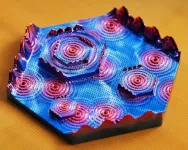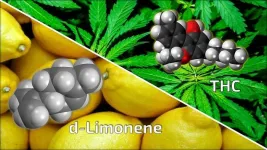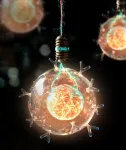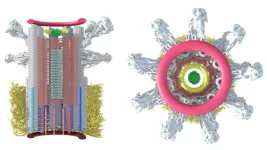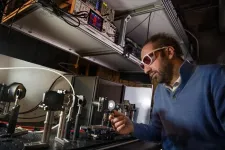(Press-News.org) Physicists have observed a novel quantum effect termed “hybrid topology” in a crystalline material. This finding opens up a new range of possibilities for the development of efficient materials and technologies for next-generation quantum science and engineering.
The finding, published in the April 10th issue of Nature, came when Princeton scientists discovered that an elemental solid crystal made of arsenic (As) atoms hosts a never-before-observed form of topological quantum behavior. They were able to explore and image this novel quantum state using a scanning tunneling microscope (STM) and photoemission spectroscopy, the latter a technique used to determine the relative energy of electrons in molecules and atoms.
This state combines, or “hybridizes,” two forms of topological quantum behavior—edge states and surface states, which are two types of quantum two-dimensional electron systems. These have been observed in previous experiments, but never simultaneously in the same material where they mix to form a new state of matter.
“This finding was completely unexpected,” said M. Zahid Hasan, the Eugene Higgins Professor of Physics at Princeton University, who led the research. “Nobody predicted it in theory before its observation.”
In recent years, the study of topological states of matter has attracted considerable attention among physicists and engineers and is presently the focus of much international interest and research. This area of study combines quantum physics with topology — a branch of theoretical mathematics that explores geometric properties that can be deformed but not intrinsically changed.
For more than a decade, scientists have used bismuth (Bi)-based topological insulators to demonstrate and explore exotic quantum effects in bulk solids mostly by manufacturing compound materials, like mixing Bi with selenium (Se), for example. However, this experiment is the first time topological effects have been discovered in crystals made of the element As.
“The search and discovery of novel topological properties of matter have emerged as one of the most sought-after treasures in modern physics, both from a fundamental physics point of view and for finding potential applications in next-generation quantum science and engineering,” said Hasan. “The discovery of this new topological state made in an elemental solid was enabled by multiple innovative experimental advances and instrumentations in our lab at Princeton.”
An elemental solid serves as an invaluable experimental platform for testing various concepts of topology. Up until now, bismuth has been the only element that hosts a rich tapestry of topology, leading to two decades of intensive research activities. This is partly attributed to the material's cleanliness and the ease of synthesis. However, the current discovery of even richer topological phenomena in arsenic will potentially pave the way for new and sustained research directions.
“For the first time, we demonstrate that, akin to different correlated phenomena, distinct topological orders can also interact and give rise to new and intriguing quantum phenomena,” Hasan said.
A topological material is the main component used to investigate the mysteries of quantum topology. This device acts as an insulator in its interior, which means that the electrons inside are not free to move around and therefore do not conduct electricity. However, the electrons on the device’s edges are free to move around, meaning they are conductive. Moreover, because of the special properties of topology, the electrons flowing along the edges are not hampered by any defects or deformations. This of type device has the potential not only of improving technology but also of generating a greater understanding of matter itself by probing quantum electronic properties.
Hasan noted that there is much interest in using topological materials for practical applications. But two important advances need to happen before this can be realized. First, quantum topological effects must be manifested at higher temperatures. Second, simple and elemental material systems (like silicon for conventional electronics) that can host the topological phenomena need to be found.
“In our labs we have efforts in both directions — we are searching for simpler materials systems with ease of fabrication where essential topological effects can be found,” said Hasan. “We are also searching for how these effects can be made to survive at room temperature.”
Background of the experiment
The discovery’s roots lie in the workings of the quantum Hall effect — a form of topological effect that was the subject of the Nobel Prize in Physics in 1985. Since that time, topological phases have been studied and many new classes of quantum materials with topological electronic structures have been found. Most notably, Daniel Tsui, the Arthur Legrand Doty Professor of Electrical Engineering, Emeritus, at Princeton, won the 1998 Nobel Prize in Physics for discovering the fractional quantum Hall effect. Similarly, F. Duncan Haldane, the Eugene Higgins Professor of Physics at Princeton, won the 2016 Nobel Prize in Physics for theoretical discoveries of topological phase transitions and a type of two-dimensional (2D) topological insulator. Subsequent theoretical developments showed that topological insulators can take the form of two copies of Haldane’s model based on electron’s spin-orbit interaction.
Hasan and his research team have been following in the footsteps of these researchers by investigating other aspects of topological insulators and searching for novel states of matter. This led them, in 2007, to the discovery of the first examples of three-dimensional (3D) topological insulators. Since then, Hasan and his team have been on a decade-long search for a new topological state in its simplest form that can also operate at room temperature.
“A suitable atomic chemistry and structure design coupled to first-principles theory is the crucial step to make topological insulator’s speculative prediction realistic in a high-temperature setting,” said Hasan. “There are hundreds of quantum materials, and we need both intuition, experience, materials-specific calculations and intense experimental efforts to eventually find the right material for in-depth exploration. And that took us on a decade-long journey of investigating many bismuth-based materials leading to many foundational discoveries.”
The experiment
Bismuth-based materials are capable, at least in principle, of hosting a topological state of matter at high temperatures. But these require complex materials preparation under ultra-high vacuum conditions, so the researchers decided to explore several other systems. Postdoctoral researcher Md. Shafayat Hossain suggested a crystal made of arsenic because it can be grown in a form that is cleaner than many bismuth compounds.
When Hossain and Yuxiao Jiang, a graduate student in the Hasan group, turned the STM on the aresenic sample, they were greeted with a dramatic observation — grey arsenic, a form of arsenic with a metallic appearance, harbors both topological surface states and edge states simultaneously.
“We were surprised. Grey arsenic was supposed to have only surface states. But when we examined the atomic step edges, we also found beautiful conducting edge modes,” said Hossain.
“An isolated monolayer step edge should not have a gapless edge mode,” added Jiang, a co-first author of the study.
This is what is seen in calculations by Frank Schindler, postdoctoral fellow and condensed matter theorist at the Imperial College London in the United Kingdom, and Rajibul Islam, a postdoctoral researcher at the University of Alabama in Birmingham, Alabama. Both are co-first authors on the paper.
“Once an edge is placed on top of the bulk sample, the surface states hybridize with the gapped states on the edge and form a gapless state,” Schindler said.
“This is the first time we have seen such a hybridization,” he added.
Physically, such a gapless state on the step edge is not expected for either strong or higher-order topological insulators separately, but only for hybrid materials where both kinds of quantum topology are present. This gapless state is also unlike surface or hinge states in strong and higher-order topological insulators, respectively. This meant that the experimental observation by the Princeton team immediately indicated a never-before-observed type of topological state.
David Hsieh, Chair of the Physics Division at Caltech and a researcher who was not involved in the study, pointed to the study’s innovative conclusions.
“Typically, we consider the bulk band structure of a material to fall into one of several distinct topological classes, each tied to a specific type of boundary state,” Hsieh said. “This work shows that certain materials can simultaneously fall into two classes. Most interestingly, the boundary states emerging from these two topologies can interact and reconstruct into a new quantum state that is more than just a superposition of its parts.”
The researchers further substantiated the scanning tunneling microscopy measurements with systematic high-resolution angle-resolved photoemission spectroscopy.
“The grey As sample is very clean and we found clear signatures of a topological surface state,” said Zi-Jia Cheng, a graduate student in the Hasan group and a co-first author of the paper who performed some of the photoemission measurements.
The combination of multiple experimental techniques enabled the researchers to probe the unique bulk-surface-edge correspondence associated with the hybrid topological state — and corroborate the experimental findings.
Implications of the findings
The impact of this discovery is two-fold. The observation of the combined topological edge mode and the surface state paves the way to engineer new topological electron transport channels. This may enable the designing of new quantum information science or quantum computing devices. The Princeton researchers demonstrated that the topological edge modes are only present along specific geometrical configurations that are compatible with the crystal’s symmetries, illuminating a pathway to design various forms of future nanodevices and spin-based electronics.
From a broader perspective, society benefits when new materials and properties are discovered, Hasan said. In quantum materials, the identification of elemental solids as material platforms, such as antimony hosting a strong topology or bismuth hosting a higher-order topology, has led to the development of novel materials that have immensely benefited the field of topological materials.
“We envision that arsenic, with its unique topology, can serve as a new platform at a similar level for developing novel topological materials and quantum devices that are not currently accessible through existing platforms," Hasan said.
The Princeton group has designed and built novel experiments for the exploration of topological insulators materials for over 15 years. Between 2005 and 2007, for example, the team led by Hasan discovered topological order in a three-dimensional bismuth-antimony bulk solid, a semiconducting alloy and related topological Dirac materials using novel experimental methods. This led to the discovery of topological magnetic materials. Between 2014 and 2015, they discovered and developed a new class of topological materials called magnetic Weyl semimetals.
The researchers believe this finding will open the door to a whole host of future research possibilities and applications in quantum technologies, especially in so-called “green” technologies.
“Our research is a step forward in demonstrating the potential of topological materials for quantum electronics with energy-saving applications,” Hasan said.
The team included numerous researchers from Princeton’s Department of Physics, including present and past graduate students Yu-Xiao Jiang, Maksim Litskevich, Xian P. Yang, Zi-Jia Cheng, Tyler Cochran, Nana Shumiya, and Daniel Multer, and present and past postdoctoral research associates Shafayat Hossain, Jia-Xin Yin, Guoqing Chang and Qi Zhang.
The paper, “A hybrid topological quantum state in an elemental solid,” by Md Shafayat Hossain, Frank Schindler, Rajibul Islam, Zahir Muhammad, Yu-Xiao Jiang, Zi-Jia Cheng, Qi Zhang, Tao Hou, Hongyu Chen, Maksim Litskevich, Brian Casas, Jia-Xin Yin, Tyler A. Cochran, Mohammad Yahyavi, Xian P. Yang, Luis Balicas, Guoqing Chang, Weisheng Zhao, Titus Neupert and M. Zahid Hasan was published online in the April 10 issue of Nature (DOI: 10.1038/s41563-022-01304-3).
Primary support for the work at Princeton is from the U.S. Department of Energy (DOE) Office of Science, the National Quantum Information (NQI) Science Research Centers, the Quantum Science Center (QSC at ORNL) and Princeton University. Support from the U.S. DOE under the Basic Energy Sciences program (grant number DOE/BES DE-FG-02-05ER46200) was provided for the theory and advanced ARPES experiments. Support for advanced STM Instrumentation and theory work comes from the Gordon and Betty Moore Foundation (GBMF9461). Additional support is reported in the paper.
END
Physicists discover a novel quantum state in an elemental solid
Princeton University find that a crystal of arsenic hosts a new type of quantum behavior
2024-04-10
ELSE PRESS RELEASES FROM THIS DATE:
Researchers show chemical found naturally in cannabis may reduce anxiety-inducing effects of THC
2024-04-10
FOR IMMEDIATE RELEASE
A Johns Hopkins Medicine-led research team has added to evidence that a chemical found naturally in cannabis (also known as marijuana) can — in the right amounts — lessen the anxiety-inducing effects of tetrahydrocannabinol (THC), the primary psychoactive sister chemical found in cannabis. The finding has the potential to advance the medicinal use of THC, and reduce the risks of its recreational use in some people.
The substance, called d-limonene, is one of the most abundant terpenes, or essential oils, in the cannabis plant, and has shown promise in rodent studies in reducing anxiety behaviors. However, there has ...
AI-powered ‘sonar’ on smartglasses tracks gaze, facial expressions
2024-04-10
ITHACA, N.Y. – Cornell University researchers have developed two technologies that track a person’s gaze and facial expressions through sonar-like sensing. The technology is small enough to fit on commercial smartglasses or virtual reality or augmented reality headsets, yet consumes significantly less power than similar tools using cameras.
Both use speakers and microphones mounted on an eyeglass frame to bounce inaudible soundwaves off the face and pick up reflected signals caused by face and eye movements. ...
Newly found genetic variant defends against Alzheimer’s disease
2024-04-10
NEW YORK, NY (April 10, 2024)--Columbia researchers have discovered a genetic variant that reduces the odds of developing Alzheimer’s disease by up to 70% and may be protecting thousands of people in the United States from the disease.
The discovery of the protective variant, which appears to allow toxic forms of amyloid out of the brain and through the blood-brain barrier, supports emerging evidence that the brain’s blood vessels play a large role in Alzheimer's disease and could herald a new direction in therapeutic development.
“Alzheimer’s disease may get started with amyloid deposits in the brain, but ...
Serious flu damage prevented by compound that blocks unnecessary cell death
2024-04-10
As lung cells are killed by the influenza virus, they burst open, releasing molecular signals that trigger the immune cells that can combat the infection. This strategy can be an important red flag that something is wrong; however, if one cell death response, called necroptosis, continues unchecked, it can cause life-threatening injury to lung tissue. In a study published April 10 in the journal Nature, Tufts University School of Medicine scientists and collaborators present a newly developed compound ...
CHOP, Stanford researchers identify protein that controls CAR T cell longevity
2024-04-10
Philadelphia, April 10, 2024 – CAR T cell therapy has revolutionized the way certain types of cancer are treated, and the longer those CAR T cells live in a patient’s body, the more effectively they respond to cancer. Now, in a new study, researchers at Children’s Hospital of Philadelphia (CHOP) and Stanford Medicine have found that a protein called FOXO1 improves the survival and function of CAR T cells, which may lead to more effective CAR T cell therapies and could potentially expand its use in difficult-to-treat cancers. The findings were published online today by the journal Nature.
T ...
Race, ethnicity, and delayed time to COVID-19 testing among health care workers
2024-04-10
About The Study: In this cross-sectional study of health care personnel (HCP), compared with non-Hispanic white HCP and clinical HCP with graduate degrees, non-Hispanic Black HCP, non-Hispanic HCP of other races, and HCP of all other professional and education backgrounds were more likely to have delayed COVID-19 testing. These findings suggest that time to testing may serve as a valuable metric in evaluating sociodemographic disparities in the response to COVID-19 and future health mitigation strategies.
Authors: DaMarcus ...
Trends in deaths of despair by race and ethnicity
2024-04-10
About The Study: As of 2022, the midlife mortality rates from deaths of despair (deaths from suicide, drug overdose, and alcoholic liver disease) among Black individuals were higher than rates among white individuals, and rates among American Indian or Alaska Native individuals remained higher than rates in the other groups. Rising inequalities in deaths of despair among American Indian or Alaska Native and Black individuals were largely attributable to disproportionate early mortality from drug- and alcohol-related causes, which increased leading up to and during the COVID-19 pandemic.
Authors: Joseph ...
Revolutionary molecular device unleashes potential for targeted drug delivery and self-healing materials
2024-04-10
In a new breakthrough that could revolutionise medical and material engineering, scientists have developed a first-of-its-kind molecular device that controls the release of multiple small molecules using force.
The researchers from The University of Manchester describe a force-controlled release system that harnesses natural forces to trigger targeted release of molecules, which could significantly advance medical treatment and smart materials.
The discovery, published today in the journal Nature, uses a novel technique using a type of interlocked molecule known as rotaxane. Under the influence of mechanical force - such ...
The genesis of our cellular skeleton, image by image
2024-04-10
Cells contain various specialised structures - such as the nucleus, mitochondria or peroxisomes - known as “organelles’’. Tracing their genesis and determining their structure is fundamental to understanding cell function and the pathologies linked to their dysfunction. Scientists at the University of Geneva (UNIGE) have combined high resolution microscopy and kinematic reconstruction techniques to visualise, in motion, the genesis of the human centriole. This organelle, essential to the organisation of the cell skeleton, is associated - in case of dysfunction - with certain cancers, brain disorders or retinal diseases. This work, published in the journal Cell, elucidates ...
Quantum breakthrough when light makes materials magnetic
2024-04-10
The potential of quantum technology is huge but is today largely limited to the extremely cold environments of laboratories. Now, researchers at Stockholm University, at the Nordic Institute for Theoretical Physics and at the Ca’ Foscari University of Venice have succeeded in demonstrating for the very first time how laser light can induce quantum behavior at room temperature – and make non-magnetic materials magnetic. The breakthrough is expected to pave the way for faster and more energy-efficient computers, information transfer and data storage.
Within a few decades, the advancement of quantum technology ...
LAST 30 PRESS RELEASES:
Stardust study resets how life’s atoms spread through space
Practical education: Clinical scenario-based program development
The impact of family dynamics on eating behaviour – how going home for Christmas can change how you eat
Tracing the quick synthesis of an industrially important catalyst
New software sheds light on cancer’s hidden genetic networks
UT Health San Antonio awarded $3 million in CPRIT grants to bolster cancer research and prevention efforts in South Texas
Third symposium spotlights global challenge of new contaminants in China’s fight against pollution
From straw to soil harmony: International team reveals how biochar supercharges carbon-smart farming
Myeloma: How AI is redrawing the map of cancer care
Manhattan E. Charurat, Ph.D., MHS invested as the Homer and Martha Gudelsky Distinguished Professor in Medicine at the University of Maryland School of Medicine
Insilico Medicine’s Pharma.AI Q4 Winter Launch Recap: Revolutionizing drug discovery with cutting-edge AI innovations, accelerating the path to pharmaceutical superintelligence
Nanoplastics have diet-dependent impacts on digestive system health
Brain neuron death occurs throughout life and increases with age, a natural human protein drug may halt neuron death in Alzheimer’s disease
SPIE and CLP announce the recipients of the 2025 Advanced Photonics Young Innovator Award
Lessons from the Caldor Fire’s Christmas Valley ‘Miracle’
Ant societies rose by trading individual protection for collective power
Research reveals how ancient viral DNA shapes early embryonic development
A molecular gatekeeper that controls protein synthesis
New ‘cloaking device’ concept to shield sensitive tech from magnetic fields
Researchers show impact of mountain building and climate change on alpine biodiversity
Study models the transition from Neanderthals to modern humans in Europe
University of Phoenix College of Doctoral Studies releases white paper on AI-driven skilling to reduce burnout and restore worker autonomy
AIs fail at the game of visual “telephone”
The levers for a sustainable food system
Potential changes in US homelessness by ending federal support for housing first programs
Vulnerability of large language models to prompt injection when providing medical advice
Researchers develop new system for high-energy-density, long-life, multi-electron transfer bromine-based flow batteries
Ending federal support for housing first programs could increase U.S. homelessness by 5% in one year, new JAMA study finds
New research uncovers molecular ‘safety switch’ shielding cancers from immune attack
Bacteria resisting viral infection can still sink carbon to ocean floor
[Press-News.org] Physicists discover a novel quantum state in an elemental solidPrinceton University find that a crystal of arsenic hosts a new type of quantum behavior
